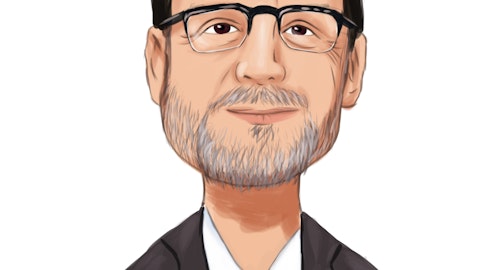Bank of Marin Bancorp (NASDAQ:BMRC) Q3 2023 Earnings Call Transcript October 23, 2023
Bank of Marin Bancorp reports earnings inline with expectations. Reported EPS is $0.33 EPS, expectations were $0.33.
Operator: Good morning, everyone. Welcome to the Bank of Marin Bancorp’s Q3 2023 Earnings Call. [Operator Instructions] I will now turn the call over to Yahaira Garcia-Perea.
Yahaira Garcia-Perea: Good morning, and thank you for joining Bank of Marin Bancorp’s earnings call for the third quarter ended September 30, 2023. I’m Yahaira Garcia-Perea, Marketing and Corporate Communications Manager for Bank of Marin. During the presentation, all participants will be in a listen-only mode. After the call, we will conduct a question-and-answer session. Joining us on the call today are Tim Myers, President and CEO; and Tani Girton, Executive Vice President and Chief Financial Officer. Our earnings press release and supplementary presentation which we issued this morning can be found in the Investor Relations portion of our website at bankofmarin.com where this call is also being webcast. Closed captioning is available during the live webcast as well as on the webcast replay.
Before we get started, I want to note that we will be discussing some non-GAAP financial measures. Please refer to the reconciliation table in our earnings press release for both GAAP and non-GAAP measures. Additionally, the discussion on this call is based on information we know as of Friday, October 20, 2023, and may contain forward-looking statements that involve risks and uncertainties. Actual results may differ materially from those set forth in such statements. For a discussion on these risks and uncertainties, please review the forward-looking statements disclosures in our earnings press release as well as our SEC filings. Following our prepared remarks, Tim, Tani and our Chief Credit Officer, Misako Stewart will be available to answer your questions.
And now, I’d like to turn the call over to Tim Myers.
Tim Myers: Thank you, Yahaira. Good morning, everyone, and welcome to our third quarter earnings call. Our improved third quarter results reflect meaningful progress that we made to reposition our balance sheet out of borrowings and securities and into deposits and cash to expand our net interest margin, increase our liquidity diversification and improve our interest-free risk position. We generated 16% sequential growth in net income while maintaining comparable loan balances, strong credit quality and well-managed expenses. We further strengthened our core deposit franchise during the quarter by engaging new customers and deepening ties with existing clients through exceptional service and our local market expertise. These efforts led to strong deposit growth for the second consecutive quarter, including growth and non-interest-bearing deposits which continue to represent 48% of our total deposits.
Notably, during the quarter, we added more than 1,200 new accounts, 38% of which were with new clients. While deposit costs increased in the quarter, the pace of increase slowed dramatically from the second quarter as we continued to effectively manage our deposit costs in an ongoing competitive environment. Interest-bearing deposit costs increased 31 basis points between June and September compared to 77 basis points between March and June. Historically, our overall cost of funds has trended well below pure averages, reflecting our long-term approach to customer engagement, which emphasizes building connections with a full suite of products and services rather than competing on price alone. We continue to work hard at improving our net interest margin by executing on our balance sheet initiatives, which not only include raising deposits and building our loan pipeline, but also reallocating part of our investment portfolio to cash and applying fair value hedges to other securities.
Those actions enabled us to expand net interest margin by 3 basis points from the second quarter. We also substantially paid down our short-term borrowings during the quarter with cash flows from our securities and loan portfolios, as well as deposit growth as part of an ongoing strategy to reduce interest costs and support our net interest margin. While borrowings and cash fluctuate with day-to-day changes in deposits, the borrowing balance net of cash fell to 0 earlier this month. We expect our funding cost increases to remain moderate in coming quarters, given expectations that Fed rate hikes and customer migration of funds from operating accounts to interest bearing accounts will continue to slow. Our loan portfolio and loan production was relatively stable in the third quarter as we remain disciplined in our underwriting.
However, our loan pipelines have expanded meaningfully and fourth-quarter loan production is shaping up to be strong, particularly in the area of commercial and industrial where we are seeing a nice diversity of attractive opportunities. We generate a momentum in the third quarter that has continued into the fourth quarter and since quarter end have funded or approved for funding amounts exceeding Q3 total originations. In most cases, our new loans are coming onto our books at meaningfully higher rates than those being paid off, and we expect this will provide further support for our NIM. David Bloom, who joined us as Executive Vice President and Head of Commercial Banking in July, is emblematic of our ongoing recruiting efforts and the results that follow.
A commercial banking veteran with more than 25 years of experience, David is responsible for the vision and growth of the Bank’s commercial banking division comprised of eight regional offices located throughout Northern California, including our wine practice. We believe his growing team is well positioned to drive further momentum late this year and moving into the new year. Importantly, with new commercial-client relationships comes the potential for fee-based opportunities and new deposits. We believe that this will help the bank generate improved profitability, continue robust earnings-generated capital and strong returns on behalf of our shareholders. Critically, as we pursue growth, we remain focused on prudent risk management and strong credit quality that reflects our consistent underwriting standards and customer selection across cycles.
We also continue to proactively manage our credit and support our borrowers, building momentum with high quality credits while carefully monitoring our loan portfolio and rating risk appropriately. Non-accrual loans totaled 0.27% of the loan portfolio at September 30 compared to 0.1% at June 30. We moved two loans totaling $4 million to non-accrual status in the third quarter. The increase was driven by a legacy acquired bank loan and we are working with that bar to ensure the best possible outcome. All of our non-accrual loans are collateralized by real estate with no expected credit loss as of quarter end. Classified loans comprised only 1.9% of total loans at quarter end, up only slightly from the prior quarter. Looking closer at our commercial real estate portfolio which accounted for 74% of our total loan balances of September 30, 23% were owner occupied which we believe carry a different risk profile than non-owner-occupied loans in this environment.
Our $364 million non-owner-occupied office portfolio is granular and consists of 142 loans with an average loan size of $2.6 million, the largest loan being $17 million. The weighted average loan to value was 56%, and the weighted average debt service coverage was 1.68 times based on our most recent data. Earlier this quarter, we conducted a review of the refinance risk in our non-owner occupied commercial real estate portfolio, the results of which can be seen on Slide 13 of the earnings presentation. We evaluated 36 loans totaling $97 million with total commitments over $1 million each that mature or reprice in 2023 or 2024. We determined that the refinance risk on these loans is manageable with weighted average debt service coverage ratios ranging from 1.28x to 2.01x across the four cohorts based on current rates.

A woman signing papers with her banker for her first home mortgage. Editorial photo for a financial news article. 8k. –ar 16:9
In summary, we made important progress on both sides of our balance sheet in the third quarter and continue to make headway as we position the bank for improved profitability in the quarters ahead. Finally, the bank is pleased to welcome Cigdem Gencer to its Board of Directors, as announced in our recent 8-K. Cigdem brings extensive leadership and financial services experience to the board, including the development and execution of transformative growth, expansion, and investment strategies for organizations. In 2021, she established an executive coaching and organizational consulting firm, and which she also serves as an executive coach. With that, I’ll turn the call over to Tani to discuss our financial results in more detail.
Tani Girton: Thanks, Tim. Good morning, everyone. First, I’ll start with some key highlights for the quarter. We generated net income of $5.3 million in the third quarter or $0.33 per diluted share up from $4.6 million or $0.28 in the second quarter. As Tim noted, the increase was driven by a 3 basis point increase in our tax equivalent net interest margin to 2.48% from 2.45% in the prior quarter due primarily to higher rates on interest-bearing cash balances generated from security sales and the addition of $102 million fair value hedges in the form of interest rate swaps. We recorded a $425,000 provision for credit losses on loans in the quarter compared to $500,000 in the prior quarter. The provision was due primarily to increases in qualitative factors related to trends in adversely graded nonowner-occupied commercial real estate loans and the potential impact of higher interest rates and other external factors on both our nonowner-occupied commercial real estate and construction portfolios.
Non-interest income totaled $2.6 million for the third quarter down $141,000 from the second quarter. The modest decline was primarily due to a decrease in debit card interchange income. The sale of $82.7 million investment securities generated a loss of $2.8 million and that loss was offset by a gain on the sale of our remaining 10,439 vis-à-vis shares, which had a zero carrying value. Non-interest expenses of $19.7 million in the quarter were down $918,000 from $20.7 million last quarter. Contributing to the reduction was a $675,000 decrease in salaries and benefits related to decreases in accrued incentive and profit-sharing expenses and 401(k) contributions. Additionally, our annual charitable contributions grant program normally occurs in the second quarter, resulting in another $618,000 reduction quarter-over-quarter.
Finally, FDIC insurance costs declined $197,000 due to a second quarter catch-up adjustment for the statutory rate increase to bolster the deposit insurance fund. These decreases were partially offset by a $533,000 net increase, other expense primarily resulting from a $688,000 increase in expenses and fees associated with our customers’ participation in reciprocal deposit networks to bolster their FDIC-insured balances. Our third quarter earnings translated into a return on assets of 0.52% and return on equity of 4.94% up from 0.44% and 4.25% in the prior quarter. The efficiency ratio improved to 72.96% from 76.91% in the prior quarter due to both higher net interest income and lower non-interest expenses. We continue to maintain a high level of capital and liquidity as well as an allowance for credit losses equal to 1.16% of total loans.
All capital levels remain strong and meaningfully above well-capitalized regulatory requirements. Our total risk-based capital improved to 16.6% and 16.1% for Bancorp and the Bank respectively during the quarter. Our TCE ratio was comparable with prior quarter, despite pressure from AOCI resulting from resulting – rising interest rates in the quarter. Bancorp’s quarter end tangible common equity was down 1 basis point to 8.63%. The $7.2 million decline in AOCI resulting from after-tax marks on our AFS portfolio, net of fair value hedges was mostly offset by earnings and a reduction in tangible assets. After adjusting for $107 million in after-tax unrealized losses in our HTM securities portfolio, our TCE ratio would be 6.1% for Bancorp. Importantly, our liquidity covers all of our uninsured deposits by over 200%.
Liquidity and contingent liquidity of approximately $2.1 billion at quarter-end consisted of cash, unencumbered securities and total borrowing capacity and does not include our ability to tap the brokered deposit market. Uninsured deposits remained at 29% of our total deposits as of September 30. Our largest depositor represented just 0.8% of total deposits and our combined four largest depositors represented 3% of total deposits. Our Board of Directors declared a cash dividend of $0.25 per share on October 20, 2023 which represents the 74th consecutive quarterly dividend paid by Bancorp. As we noted on last quarter’s call, the Board of Directors renewed the share repurchase program for $25 million effective through July 2025. There have been no repurchases in 2023 as we have focused on continuing to build upon our already strong capital position.
We continue to believe that our emphasis on the fundamentals of relationship banking and risk management, combined with our strong liquidity and capital will continue to serve our customers and shareholders well across all interest rate and economic cycles. At Bank of Marin, we are committed to fostering a culture of excellence, effort and engagement as our teams work together on the execution of our strategies to increase operational efficiencies and improve long-term profitability. With that, I’ll turn it back to Tim to share some final comments.
Tim Myers: Thank you, Tani. In conclusion, we continue to build upon our valuable core deposit franchise in the third quarter. Emphasizing our relationship-based banking model to increase deposits while maintaining an attractive deposit mix and healthy liquidity levels. We also proactively managed our balance sheet enabling us to expand our net interest margin in the quarter. We bolstered our commercial banking team and are attracting new clients that are seeking financing to pursue new opportunities and expansion plans and we are deepening our relationships with existing clients. This is enabling our lending teams to build a strong pipeline that we believe will lead to loan growth, increased interest income and ongoing margin and earnings improvement. Finally, I want to thank everyone on today’s call for your interest and your support. We will now open the call to your questions.
See also 12 Biggest Dividend Cuts and Suspensions of 2023 and Best Dividend Aristocrats According to Analysts.
Q&A Session
Follow Bank Of Marin Bancorp (NASDAQ:BMRC)
Follow Bank Of Marin Bancorp (NASDAQ:BMRC)
Operator: [Operator Instructions] Our first question comes from Jeffrey Rulis from D.A. Davidson. Your line is open. Please go ahead.
Jeff Rulis: Good morning.
Tim Myers: Good morning, Jeff.
Tani Girton: Good morning, Jeff.
Jeff Rulis: Hoping to get an update on – I think you’ve identified a couple of months ago, that the percent of loans that we’re repricing in the next 12 months, I think it was around 30%. Has that meaningfully changed as of today?
Tim Myers: No. There’s a slide in the deck on Page 17 on – in the investor presentation on the total, but that’s – I’ll let Tani go into some of the details on that.
Tani Girton: Yes. So Jeff, the 29% in – when we discuss that in the context of our interest rate risk and where our net interest margin is headed, that includes prepayment projections, whereas what you can see on Page 17 in the deck or the presentation, if you add up the first two columns in the loan repricing schedule, that 17% there are no prepayment rates applied to that.
Jeff Rulis: Got it. Okay. And as you both kind of talked about the puts and takes of the bigger picture on margin, it sounds more positive than not. High-level margin conversation, the outlook here is to continue to scratch out some expansion or kind of how do you see it as those deposit costs kind of held it big?
Tani Girton: Yes, exactly. So we had talked about that on the last call. And I think for some of the factors, what we expected was what actually transpired. But again, that was absent any loan growth and also any change in deposits. Obviously, we had more growth in deposits and also the rates on the deposits went up. So that’s where you would have gotten the differential. So as we look forward from today with a static balance sheet. So similar expectations, obviously not quite as much lift, if we don’t make any changes associated, you know, last time we worked in the changes associated with the security sales, excuse me, and the interest rate swaps. This time, we have not done any of those as of yet this quarter. So, if you just look at a straight static balance sheet, with no changes in market rates, no changes in deposit rates, you know, that ranges from two to five basis points in lift on average margin in a quarter.
Tim Myers: Yes. I would say, Jeff, from a, less sterile standpoint, analytically and Tani’s right as we are seeing that pace of deposit cost decelerate. When you look at the deposit campaign we did, this last quarter versus the prior quarter, the weighted average cost on that was very, very similar, almost identical. And the yield on new loans coming on was 769 in the quarter. So, I think we mentioned in the script there that we have had an acceleration of loan closings. We had expected some last quarter, but those are materializing now. And so, if we get that loan growth on top of what Tani mentioned, we’re optimistic we can continue to show that expansion barring any unforeseen circumstances there.
Jeff Rulis: Great. I appreciate the color. If I could ask about the deposit side, and you talked about, I think you said 1,200 new accounts added and a large portion of those were new clients. What – if you could kind of range-bound, what the newer clients, where are they coming from? Is it from some of the struggles – or failed banks in your region? Or is it community banks? Is it larger banks? Do you get a sense for where those clients are coming from?





